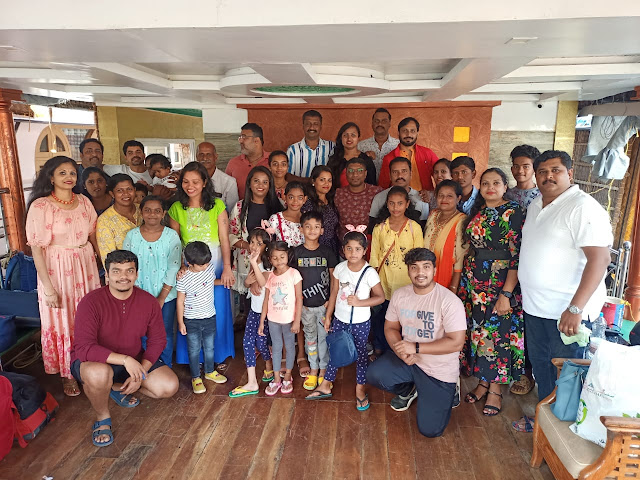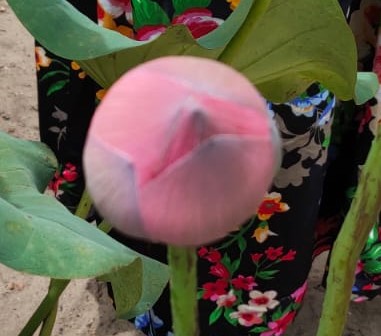The first time I heard the word Alleppey was in college. One of my juniors, Mary Abraham, was from Alleppey. She adored me, and I liked her a lot too. She would write me letters during the holidays, and send me cards for birthdays. She was so kind, soft-spoken, and gentle in her demeanor. She was strikingly fair, with long hair and a long nose, and deep, black eyes. Mary from Alleppey- the connection stayed in my mind.
Our college was run by Christian missionaries, and so there were many Malayali Christians studying in the college, doing their graduation course in the morning-to-afternoon classes, and theology in the post-lunch classes. A majority of the students came from Kannur, the northernmost district of Kerala (KL), which was infamous for strikes and protests by communists. Not many were from Alleppey and I guess that is another reason why the name stuck so strongly in my memory.
And then, there was the aggressive marketing campaign of the state government. Who in India didn't know about God's Own Country? The coconut trees, the elephants, the tea gardens, the backwaters, the houseboats, the Ayurvedic treatments - KL was a famous state and attracted hordes of travelers - both domestic and international.
Sathya & I have traveled the length and breadth of KL but somehow never went to Alleppey in all these years. Most of the early years of our married life were spent exploring the neighboring Southern states of Andhra, KL, and Tamil Nadu. Our last family trip to KL was in 2018, to Kochi. It has already been four years since we explored KL.
The state has become rabidly violent and is known for all the wrong reasons. The Covid mess-up, the ISIS recruitment, the targeted killings of RSS workers by the communists, the Muslim street marches that boldly said "Time's up for Hindus & Christians, be ready to die", and so on. The list is endless. Coincidentally, the hate speech incident of a young kid calling for the death of Hindus & Christians happened in May 2022 in Alleppey. The rally was organized by the Popular Front of India, where a mob of over 1000 Muslims called for violence against Hindus & Christians, abused them, & threatened them. Check the videos available online to see the hatred they have for "kafirs"; the venom in their vitriolic speeches. KL will soon be another Kashmir, like West Bengal has already become. Hindu ethnic cleansing pogrom is on the cards.
The only two places I want to see in this "god's own country - NO MORE", are Jathayu Park in Kollam and the 58-feet tall Shiva Murti in Azhimala. My heart longs for these.
Recently, an unexpected opportunity came our way to visit Alleppey. Sathya's office planned a houseboat trip over the weekend of July 23-24. The train tickets were booked in June. The group had 38 members including spouses & children. This was our first houseboat experience. 
I realized, on this trip, that Alleppey and Alapuzha are one and the same. Like Kochi, Cochin & Ernakulam - all same.
If you search the internet, you would find November to February to be the best months to visit Alleppey. Our visit was during peak monsoon month. Luckily for us, it didn't rain during our 2-day stay, even though it had been pouring the whole of the previous week. The weather was very pleasant, occasionally cloudy. Perfect for us to enjoy the view.
The red building in the pic below is the Ramada hotel. 

The local women fishing in coracles. 
We caught a few fish on our boat too. The children were ecstatic with the fishing experience and took turns holding the fishing rod but caught only leaves and debris.
Breakfast, lunch, evening tea & snacks, and dinner are all provided on the boat. .jpeg)
The houseboat experience is definitely over-rated. It is marketed really well, though. The photographs in travel magazines and on the internet will beckon you with a once-in-a-lifetime experience. I did not find it that great. I say that considering the amount of time and effort we spent getting to the place. 13 hours of train travel from BLR to Kottayam (8:30 p.m to 9:30 a.m), then 2 hours bus ride to the houseboat location. The return journey of 12 hours from Alleppey to BLR 7:30 p.m to 7:30 a.m. It is not worth it.
The trip ended on a sad note for us as my handbag was stolen on the train. I lost my mobile, one Samsung tab, and the house key. Early in the morning, we had to search for key maker shops to get him to break open the house lock.It took more than half an hour to break the Godrej lock open and Rs 700 in labor. And a new lock to be bought and a new phone! Sob sob!
The highlight was the unexpected darshan of Lord Shiv in the Mararikulam Devasthanam. It is at least 700 years old and is the only temple in KL where Mahadev and Parvat sit facing each other. Shivji is in the Marari roop in the temple and Parvathi in the Swayamvar roop. Marari means the Kaam hating roop of Shiv or cupid killer. Remember the story of Shiv & Sati in the post on Maa Kamakhya temple? Shivji was sad after the demise of Sati and went to the Himalayas for meditation. Meanwhile, in the devlok, the power of the Gods was overthrown and the solution was for Shiv to beget a child. Parvati was sent in the swayamvar roop to woo Shiv. To break his dhyan, Kaamdev was sent. Shivji was angry on Kaamdev for disturbing his yog sadhana, opened his third eye, and burnt him. The Umananda temple is where Kamdev was destroyed.
What a beautiful temple! The staff requested us to wait for a few minutes and take the prasadam. We happily obliged. It was our pleasure and a blessing that we happened to be there during the last aarthi (12 o'clock) and could partake in the prasada seva. 
May the Sanatana Dharma thrive in this land that was once truly God's Own Country.
At the temple, saw this beautiful flower. The staff said it is sahasra kamala.
.jpeg)












.jpeg)
.jpeg)



















